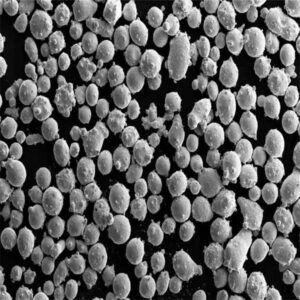ภาพรวม
สแตนเลสสตีลผง 17-4ph เป็นสแตนเลสสตีลมาร์ทิติกที่ตกตะกอนซึ่งสามารถใช้สำหรับการพิมพ์ 3 มิติโลหะ มันมีความแข็งแรงและความแข็งสูงควบคู่ไปกับความต้านทานการกัดกร่อนที่ดี 17-4ph มีทองแดงประมาณ 4% ซึ่งช่วยให้การชุบแข็งของอัลลอยอายุผ่านการตกตะกอนของอนุภาคที่อุดมด้วยทองแดง
This article provides an overview of 17-4PH powder including its composition, properties, processing, applications, suppliers, and comparisons to other alloys. Key details are summarized in the tables below.
17-4PH Powder Composition
17-4PH gets its name from its composition which includes approximately 4% copper. The main alloying elements are:
| องค์ประกอบ | น้ำหนัก % |
|---|---|
| โครเมียม | 15 – 17.5% |
| นิกเกิล | 3 – 5% |
| ทองแดง | 3 – 5% |
| แมงกานีส | ≤ 1% |
| ซิลิคอน | ≤ 1% |
| คาร์บอน | ≤ 0.07% |
| Sulfur & Phosphorus | ≤ 0.04% |
| ไนโตรเจน | ≤ 0.03% |
The copper content results in precipitation hardening which increases the strength and hardness of 17-4PH substantially. The chromium provides corrosion resistance. Nickel also boosts corrosion resistance while enhancing ductility and toughness.
17-4PH Powder Properties
17-4PH powder offers an excellent combination of high strength and good corrosion resistance. Key properties include:
| คุณสมบัติ | คำอธิบาย |
|---|---|
| ความแข็งแกร่ง | Tensile strength up to 1,380 MPa, yield strength up to 1,240 MPa |
| ความแข็ง | Up to 44 HRC after aging |
| ความต้านทานการกัดกร่อน | Better than 400 series stainless steels due to copper |
| ความสามารถกล | More difficult to machine than 300 series due to higher strength |
| Magnetism | Slightly magnetic due to martensitic microstructure |
| การเชื่อมได้ | Lower weldability than 300 series due to precipitation hardening |
The strength, hardness, and corrosion resistance can be tailored through heat treatment. Solution annealing renders the alloy soft and ductile. Subsequent aging induces precipitation of copper-rich particles which impedes dislocation movement, thereby hardening and strengthening the material.
17-4PH Processing
17-4PH powder can be processed via several metal 3D printing methods:
- ฟิวชั่นเตียงผงเลเซอร์ (L-PBF)
- Electron Beam Powder Bed Fusion (E-PBF)
- การสะสมพลังงานโดยตรง (DED)
L-PBF is one of the most common approaches. Process parameters must be carefully controlled to achieve dense, crack-free parts and avoid residual stresses.
Typical processing conditions for 17-4PH powder in L-PBF:
- ความหนาของชั้น: 20-50 μm
- Laser power: 100-400 W
- Scan speed: 100-1500 mm/s
- ระยะห่างฟัก: 80-120 μm
- Beam diameter: 50-100 μm
A stress relief heat treatment is recommended after printing to relieve residual stresses. The printed parts can be solution annealed and aged to increase hardness and strength.
17-4PH Applications
17-4PH is used for metal 3D printed parts requiring high strength, hardness, and moderate corrosion resistance across a variety of industries:
- Aerospace: Turbine blades, impellers, fasteners, brackets
- Automotive: Transmission components, turbocharger parts
- Oil & gas: Valves, wellhead parts, pumps
- General engineering: Tooling, fixtures, molds
The high hardness after aging makes 17-4PH suitable for wear-resistant applications. It can substitute for hard-to-machine materials like tool steels for injection molds and dies. The alloy is commonly used for high-strength structural brackets and housings.
17-4PH Powder Suppliers
17-4PH powder is commercially available from leading metal powder manufacturers:
| ผู้จัดหา | เกรดผลิตภัณฑ์ | ช่วงขนาด |
|---|---|---|
| Sandvik | Osprey 17-4PH | 15-45 μm |
| ช่างไม้ | 17-4F | 15-45 μm |
| แพรพ์เซอร์ | 17-4 PH | 15-53 μm |
| เทคโนโลยี LPW | 17-4F | 15-45 μm |
| ทำให้ขุ่นมัว | 17-4 PH | 20-150 μm |
Prices range from $50/lb to $90/lb depending on quantity ordered. Custom particle size distributions and high purity grades (e.g. phosphate passivated) are available.
17-4PH vs Other Alloys
17-4PH compares to stainless steel and tool steel alloys as follows:
| อัลลอยด์ | ความแข็งแกร่ง | ความต้านทานการกัดกร่อน | Comments |
|---|---|---|---|
| 17-4F | สูงมาก | ปานกลาง | Precipitation hardening; high hardness; good strength and corrosion resistance combination |
| 316 L | ปานกลาง | ยอดเยี่ยม | Standard corrosion resistant stainless; low strength; not heat treatable; cheaper |
| PH 13-8 | สูง | ยอดเยี่ยม | Precipitation hardening; high strength and corrosion resistance; contains 8% nickel |
| H13 Tool Steel | สูงมาก | ปานกลาง | Standard tool steel; high hardness but lower corrosion resistance; more expensive |
คำถามที่พบบ่อย
What are the main advantages of 17-4PH stainless steel?
The main advantages of 17-4PH are its high strength and hardness coupled with moderate corrosion resistance. Hardness values up to 44 HRC are possible through aging. It offers substantially higher strength than 300 series stainless steels.
What is 17-4PH stainless steel used for?
Common applications of 17-4PH include structural components like brackets and housings, wear-resistant parts, plastic injection molds and dies, impellers, valves, and aerospace components. It is widely used across aerospace, oil & gas, automotive, and general engineering.
Why is 17-4PH suitable for metal 3D printing?
17-4PH has low thermal conductivity and coefficient of thermal expansion, making it less prone to residual stress and cracking during printing. Its high hardness enables printing of wear resistant tooling. The alloy is commonly available in powder form.
What heat treatment is used for 17-4PH?
17-4PH is typically solution annealed at 1038-1066°C then aged at 371-427°C to precipitate copper-rich particles. This causes the alloy to harden and strengthen substantially. Stress relieving prior to heat treatment is recommended.
How does 17-4PH compare to 316L and H13 tool steel?
17-4PH has much higher strength and hardness than 316L stainless steel but lower corrosion resistance. Compared to H13 tool steel, 17-4PH offers better corrosion resistance with slightly lower hardness. 17-4PH provides a good balance between hardness, strength, and corrosion resistance.
What precautions are needed when 3D printing 17-4PH?
Careful process parameter selection and stress relieving between layers is important to minimize residual stresses and cracking. Print orientation, support structures, and resolution/layer height must also be optimized for complex geometries.
What suppliers offer 17-4PH powder?
Leading suppliers of 17-4PH powder include Sandvik, Carpenter Additive, Praxair, LPW Technology, and Erasteel. Powder is available in different size distributions customized for AM processes like DED and L-PBF.








